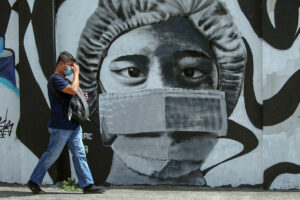THE PHILIPPINES posted 14,640 coronavirus infections in the past week, with a daily average of 2,091 cases, according to health authorities.
The daily average from July 11 to 17 rose by 44% from a week earlier, the Department of Health (DoH) said in a bulletin. Of the new patients, 35 were severe and critical, it added.
One death was confirmed in the past week, but there were no deaths from July 4 to 17, the agency said.
It added that 481 of 2,630 intensive care unit (ICU) beds had been used as of July 18, while 5,189 of 21,809 non-ICU beds were occupied. There were 589 severe and critical admissions.
The coronavirus infection rate in the Philippines has increased in recent weeks, sparking discussions on whether it is safe to enforce face-to-face classes by November.
The infection rate in capital region was 12.6% as of July 16, up from 10.9% a week earlier, OCTA Research Group fellow Fredegusto “Guido” P. David tweeted.
“The public is strongly advised to practice necessary cautions to prevent COVID-19 infections, especially in provinces where positivity rates are very high (above 20%).”
The infection rate should remain below 5% to get coronavirus cases under control, according to the World Health Organization.
President Ferdinand R. Marcos, Jr. at the weekend said his government would start a campaign to encourage more Filipinos to get booster shots against the coronavirus.
The program is part of preparations for face-to-face classes and full economic reopening, he said in his latest video blog.
The Health, the Interior and Local Government, and Education departments would lead the campaign to increase the country’s booster uptake, he said.
Mr. Marcos, 64, recently finished his seven-day isolation on Friday after he tested positive for the coronavirus.
Waning immunity against the coronavirus among Filipinos and increased movement could trigger “small waves” of infections, Jomar F. Rabajante of the University of the Philippines’ Pandemic Response Team told ABS-CBN Teleradyo.
The seesawing infection trend could lead to “small ripples” that will continue until yearend, he said. “We are seeing small waves like this in the coming months,” he said in Filipino.
He said the government must ensure that schools and workplaces are safe for students and workers. There should be proper ventilation and isolation facilities for those who may catch the virus, he added.
The Health department should approve a proposal by businesses to lower the minimum age requirement for a second booster shot to 50 years instead of 60, Jose Maria A. Concepcion III, a member of the government’s Private Sector Advisory Council, told a televised news briefing.
“By now, we’re already at the sixth month from the first booster shot,” he said. “We requested that they bring down the age of the second booster shot to 50 years old I’m told that the second booster shot is being reviewed now in America and other countries to be given to everyone.”
Only seniors and health workers may get their second booster shot now.
Mr. Concepcion cited a slight delay in the administration of the first booster shot, which was first rolled out in the country in November. “We are in a crisis and the sense of urgency must be there.”
As of July 17, 15.6 million people have received booster shots, according to the DoH bulletin. More than 71 million people have been fully vaccinated against the coronavirus.
“Right now, 70% of Filipinos have taken their primary doses. Our objective is that in terms of booster update, we need to hit at least 70% of that 70%,” Mr. Concepcion said.
The businessman has been lobbying for reforms in the Health department’s Health Technology Assessment Council, which he said has failed to accelerate the government’s booster program. — Kyle Aristophere T. Atienza

